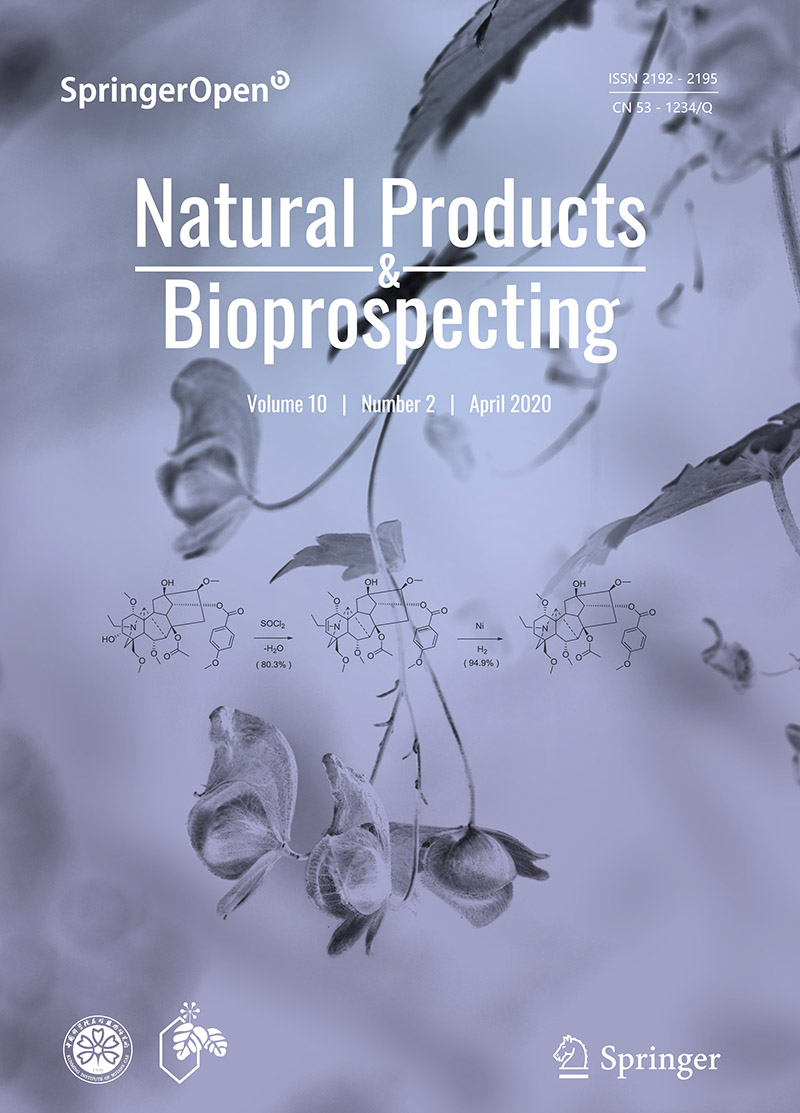|
|
Preparation and Certification of a New Salvianolic Acid A Reference Material for Food and Drug Research
Collect
Dezhi Yang, Bin Su, Yancai Bi, Li Zhang, Baoxi Zhang, Junke Song, Yang Lu, Guanhua Du
Natural Products and Bioprospecting. 2020, 10 (2): 67-76.
DOI: 10.1007/s13659-020-00236-2
Salvianolic acid A (Sal A), a water-soluble ingredient in Danshen, has various biological activities. Sal A and its impurities have similar physical and chemical properties, as well as strong reducibility; therefore, they are difficult to prepare and purify. In this study, high-purity Sal A was obtained by purification of sephadex chromatography and preparative chromatography. Furthermore, HPLC-DAD tandem ECD and HPLC-DAD tandem MS methods were used for non-volatile organic impurity analysis, ICP-MS method was used for non-volatile inorganic impurities and mass balance method and quantitative nuclear magnetic resonance were employed to certify the product. The structures of Sal A and its relative impurities were validated by nuclear magnetic resonance spectroscopy and mass spectrometry, and their contents were quantified as well. Following the principles of ISO Guides 34:2009 and 35:2005, a Sal A reference material was certified, covering homogeneity studies, stability studies, characterization, and uncertainty estimations.
References |
Related Articles |
Metrics
|
|
|
Acute and Chronic Toxicity of Indole Alkaloids from Leaves of Alstonia scholaris (L.) R. Br. in Mice and Rats
Collect
Yun-Li Zhao, Min Su, Jian-Hua Shang, Xia Wang, Guy Sedar Singor Njateng, Guang-Lei Bao, Jia Ma, Qing-Di Sun, Fang Yuan, Jing-Kun Wang, Xiao-Dong Luo
Natural Products and Bioprospecting. 2020, 10 (2): 77-88.
DOI: 10.1007/s13659-020-00237-1
Alstonia scholaris (L.) R. Br. (Apocynaceae) is an evergreen tree that has been used to treat lung diseases. In this study, the toxicity profile of indole alkaloids from leaves of A. scholaris was investigated. In acute toxicity tests, mice were administered total alkaloids (TA) and five indole alkaloids. In a chronic toxicity test, rats were continuously administered TA (50, 100, and 300 mg/kg bw) for 13 weeks, followed by a 4-week recovery. A single administration of TA affected the behavior of mice, and at 12.8 g/kg bw, prone position, shortness of breath, wheezing, and convulsion were observed. The half-lethal dose (LD50) in mice was 5.48 g/kg bw, almost 2740 times the clinical dose in humans. Among the five indole alkaloids, the maximum tolerance dose in mice ranged from 0.75 to 4 g/kg bw. The TA-treated rats did not die and showed no adverse effects or dose-dependent changes in weight or food and water consumption, despite fluctuations in hematological and biochemical parameters compared with historical data. Furthermore, both gross and histopathological observations revealed no abnormalities in any organ. With daily oral administration to rats, the non-observed-adverse-effect-level of TA was 100 mg/kg bw. The results indicate that TA is safe for clinical use.
References |
Related Articles |
Metrics
|
|
|
Irlactane and Tremulane Sesquiterpenes from the Cultures of the Medicinal Fungus Irpex lacteus HFG1102
Collect
He-Ping Chen, Xu Ji, Zheng-Hui Li, Tao Feng, Ji-Kai Liu
Natural Products and Bioprospecting. 2020, 10 (2): 89-100.
DOI: 10.1007/s13659-020-00239-z
A new irlactane-type, namely irlactin K (1), and 22 tremulane-type sesquiterpenes including fourteen previously undescribed ones, namely irpexolactins A-N (2-15), and a known irlactane-type sesquiterpenoid, were isolated from the fermentation broth of the medicinal fungus Irpex lacteus HFG1102. The structures of all the isolates were characterized by extensive spectroscopic methods, including 1D and 2D NMR and MS spectroscopic analysis. The absolute configurations of irlactin K and the known compound conocenol B (20) were established by single-crystal X-ray diffraction analysis. The vasorelaxant effects of irlactin K (1), irpexolactins A (2), C (4), K (12), and irlactam (22) were evaluated.
References |
Related Articles |
Metrics
|
|

